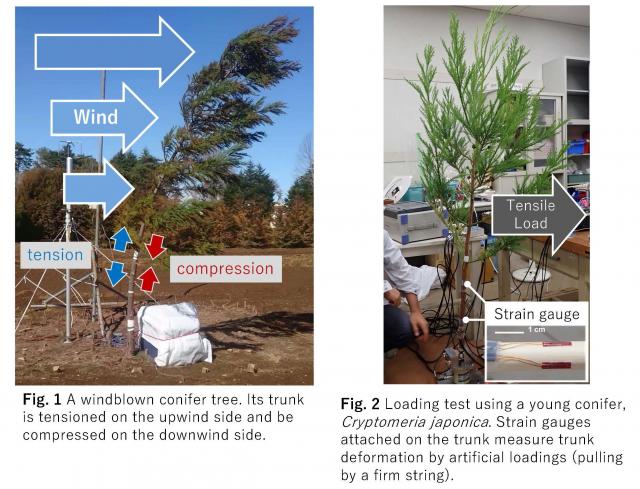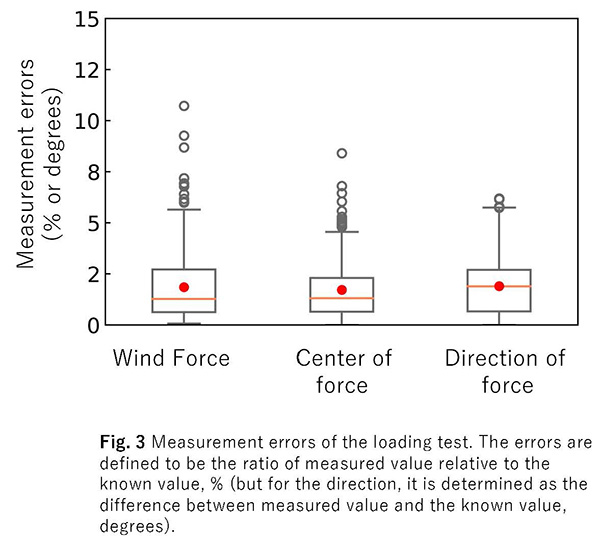Home > Research > News > Special Program for IUFRO World Day > Static event > A Method for Measuring Wind Force Acted on a Tree
Update:September 27, 2021
Main content starts here.
A Method for Measuring Wind Force Acted on a Tree
Ayana Miyashita (Center for Forest Damage and Risk Management)
Headlin
We developed a method for measuring the wind force acting on a tree using strain gauges. Direct measurement of wind force can be performed in the field, and the method can be applied to evaluate wind damage risk to trees in a forest.
Highlights
Trees in the field are always exposed to the weather (Fig. 1). Currently, there are no methods available to measure the wind force exerted on a tree trunk directly. We offer a method using strain gauges that precisely measures the amount of force, center of force, and direction of force acing on a trunk. Our method retains high accuracy regardless of lack of uniformity in the wood material or lack of operator accuracy in attaching the sensors. Having conducted loading tests on a young conifer tree (Fig. 2), we found that our method measured the amount of force and center of force with errors of <2% and the direction of force with an error of <2° (Fig. 3). Our method will be a powerful tool for evaluating wind damage risk for trees in various stand conditions.


Background and Aims
To reveal wind force acted on a tree
The wind force acting on a tree trunk is unevenly distributed along the trunk height (Fig. 1) and changes instantaneously in magnitude and direction. When the wind force exceeds the strength of a tree trunk or the root resistance, trunk breakage or uprooting occurs. However, there are almost no data for wind force measured in situ, and the actual state of trees experiencing strong wind is not clear.
To understand mechanisms for wind damage of trees
Evaluation and prediction of wind damage risk for forest trees is a subject of interest worldwide. Wind damage causes economic loss in plantations and destruction of infrastructure and houses and affects forest management. For a plantation stand, it is known that artificial thinning can increase the risk of wind damage for the remaining trees. However, knowledge of quantitative relationships between management methods and risks is lacking.
Notable Points
Wind force measurement based on trunk strain
We used strain gauges for the wind force measurement. It can measure deformation of material with high resolution at high speed having a small and thin body (Fig. 2), and it is usually inexpensive. Attaching strain gauges on several points of a tree trunk and monitoring their difference when the trunk was bended, we calculated the amount of force, center of force and direction of force exerted on the trunk. However, it is not easy to deal with a living tree. For example, wood material is not uniform, so if the same loading force was applied each point on the trunk surface will not be strained in the same manner: It is difficult to attach a strain gauge precisely at the aimed point on a leaning and uneven tree trunk in the field condition. In this study we developed a method to compensate these issues, and attained a new method for accurate wind force measurement on a living tree.
For more details,
Miyashita A. et al. (2021) A method for measuring the forces acting on a tree trunk using strain gauges. PLoS ONE https://doi.org/10.1371/journal.pone.0245631
Future Perspective
To quantitatively understand effect of forest management
We plan to test how artificial thinning changes wind load acting on each tree in a forest, with the aim of determining the quantitative relationships between risk of wind damage and method of thinning. We will examine difference in the force among trees differing height/diameter ratio, position in the stand, etc., in addition to the difference between before and after the thinning. Such data are scarce now. In the quantitative relationships between risk of wind damage and method of forest management will be understood.
To reveal what happens when the strong wind blows
The “wind force sensor” can be a tool for understanding wind profiles within a forest. By our method the amount of force and the center of force acting on a tree are separately measured. It can be a way to indirectly measure the wind profiles in a forest, which is very difficult to be measured using anemometers in a dense forest. We hope to reveal what mechanical interactions occur when the strong wind blows and trees are damaged. Our method enables a tree to be used as a “wind force sensor.” It is applicable to reveal actual wind force or wind flow in a forest.
Copyright © Forest Research and Management Organization. All rights reserved.
